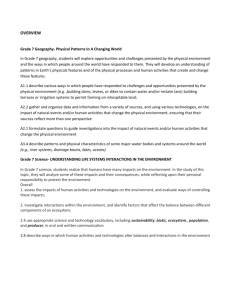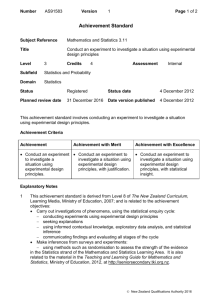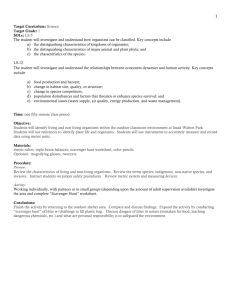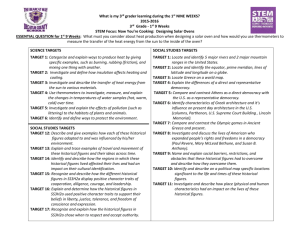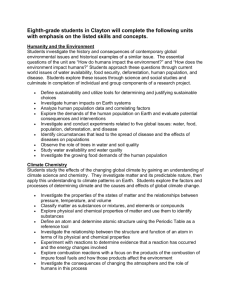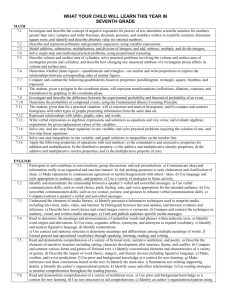AP Biology Expectations and Big Ideas
advertisement
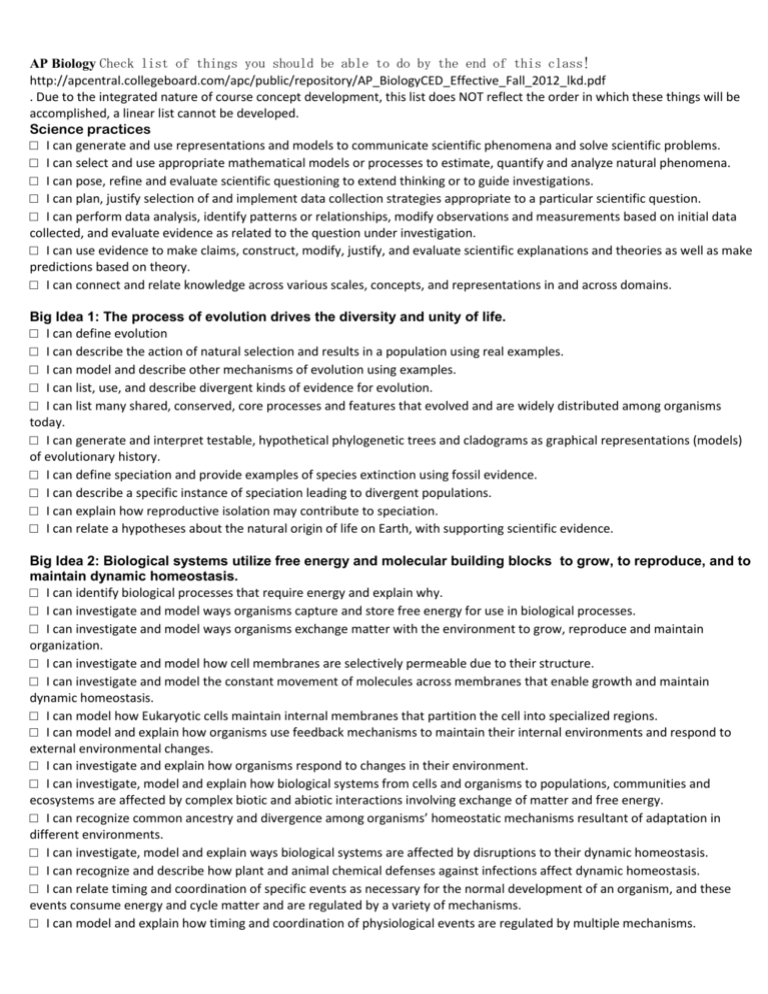
AP Biology Check list of things you should be able to do by the end of this class! http://apcentral.collegeboard.com/apc/public/repository/AP_BiologyCED_Effective_Fall_2012_lkd.pdf . Due to the integrated nature of course concept development, this list does NOT reflect the order in which these things will be accomplished, a linear list cannot be developed. Science practices □ I can generate and use representations and models to communicate scientific phenomena and solve scientific problems. □ I can select and use appropriate mathematical models or processes to estimate, quantify and analyze natural phenomena. □ I can pose, refine and evaluate scientific questioning to extend thinking or to guide investigations. □ I can plan, justify selection of and implement data collection strategies appropriate to a particular scientific question. □ I can perform data analysis, identify patterns or relationships, modify observations and measurements based on initial data collected, and evaluate evidence as related to the question under investigation. □ I can use evidence to make claims, construct, modify, justify, and evaluate scientific explanations and theories as well as make predictions based on theory. □ I can connect and relate knowledge across various scales, concepts, and representations in and across domains. Big Idea 1: The process of evolution drives the diversity and unity of life. □ I can define evolution □ I can describe the action of natural selection and results in a population using real examples. □ I can model and describe other mechanisms of evolution using examples. □ I can list, use, and describe divergent kinds of evidence for evolution. □ I can list many shared, conserved, core processes and features that evolved and are widely distributed among organisms today. □ I can generate and interpret testable, hypothetical phylogenetic trees and cladograms as graphical representations (models) of evolutionary history. □ I can define speciation and provide examples of species extinction using fossil evidence. □ I can describe a specific instance of speciation leading to divergent populations. □ I can explain how reproductive isolation may contribute to speciation. □ I can relate a hypotheses about the natural origin of life on Earth, with supporting scientific evidence. Big Idea 2: Biological systems utilize free energy and molecular building blocks to grow, to reproduce, and to maintain dynamic homeostasis. □ I can identify biological processes that require energy and explain why. □ I can investigate and model ways organisms capture and store free energy for use in biological processes. □ I can investigate and model ways organisms exchange matter with the environment to grow, reproduce and maintain organization. □ I can investigate and model how cell membranes are selectively permeable due to their structure. □ I can investigate and model the constant movement of molecules across membranes that enable growth and maintain dynamic homeostasis. □ I can model how Eukaryotic cells maintain internal membranes that partition the cell into specialized regions. □ I can model and explain how organisms use feedback mechanisms to maintain their internal environments and respond to external environmental changes. □ I can investigate and explain how organisms respond to changes in their environment. □ I can investigate, model and explain how biological systems from cells and organisms to populations, communities and ecosystems are affected by complex biotic and abiotic interactions involving exchange of matter and free energy. □ I can recognize common ancestry and divergence among organisms’ homeostatic mechanisms resultant of adaptation in different environments. □ I can investigate, model and explain ways biological systems are affected by disruptions to their dynamic homeostasis. □ I can recognize and describe how plant and animal chemical defenses against infections affect dynamic homeostasis. □ I can relate timing and coordination of specific events as necessary for the normal development of an organism, and these events consume energy and cycle matter and are regulated by a variety of mechanisms. □ I can model and explain how timing and coordination of physiological events are regulated by multiple mechanisms. □ I can model and explain how timing and coordination of behavior are regulated by various mechanisms and are important in natural selection. Big Idea 3: Living systems store, retrieve, transmit, and respond to information essential to life processes. □ I can model and explain how the shared characteristic of DNA, and in some cases RNA, is the primary source of heritable information. □ I can model and explain how eukaryotes heritable information is passed to the next generation via processes that include the cell cycle and mitosis or meiosis plus fertilization. □ I can model and explain how the chromosomal basis of inheritance provides an understanding of the pattern of passage (transmission) of genes from parent to offspring. □ I can investigate, model and explain inheritance patterns other than Mendelian patterns of inheritance. □ I can model, and describe various gene regulation strategies and the results in differential gene expression, leading to cell specialization. □ I can model and explain a variety of intercellular and intracellular signal transmissions mediate gene expression. □ I can investigate and explain how changes in genotype can result in changes in phenotype. □ I can recognize, model and explain multiple processes that increase genetic variation in biological systems. □ I can use models to explain how viral replication results in genetic variation, and viral infection can introduce genetic variation into the hosts. □ I can identify and model shared common features of cell communication processes that reflect a shared evolutionary history. □ I can identify and explain using models how cells communicate with each other through direct contact with other cells or from a distance via chemical signaling. □ I can use models to visualize and conceptualize signal transduction pathways linking signal reception with cellular responses. □ I can predict how changes in signal transduction pathways can alter cellular response. □ I can investigate and communicate observations regarding how individuals act on information and communicate it to others. □ I can investigate, model and explain how animal nervous systems detect external and internal signals, transmit and integrate information, and produce responses. Big Idea 4: Biological systems interact, and these systems and their interactions possess complex properties. □ I can identify, investigate, model and describe how the subcomponents of biological molecules and their sequence determine the properties of that molecule. □ I can relate the structure to the function of subcellular components, and their interactions, that lead to the essential cellular emergent properties. □ I can recognize, model and explain interactions between external stimuli and regulated gene expression that result in specialization of cells, tissues and organs. □ I can investigate, recognize and provide examples of organisms exhibiting complex properties due to interactions between their constituent parts. □ I can model and describe examples of communities composed of populations that interact in complex ways. □ I can investigate, model and describe the interactions among living systems and with their environment that cycle matter and transfer energy. □ I can investigate, model and explain interactions between molecules the relationship between structure and function. □ I can describe and model examples of cooperative interactions within organisms promoting efficient use of energy and matter. □ I can predict how particular interactions between and within populations influence patterns of species distribution and abundance. □ I can account for the distribution of local and global ecosystems and how that distribution changes over time. □ I can account for the various cellular functions in terms of variation in molecular units. □ I can provide examples of and predict how environmental factors influence the expression of the genotype in an organism. □ I can account for various rates of change in populations in terms of inherent population variation in relation to environmental pressures. □ I can describe the variables and predict the outcome for ecosystems as related to the system’s species diversity and abundance.



